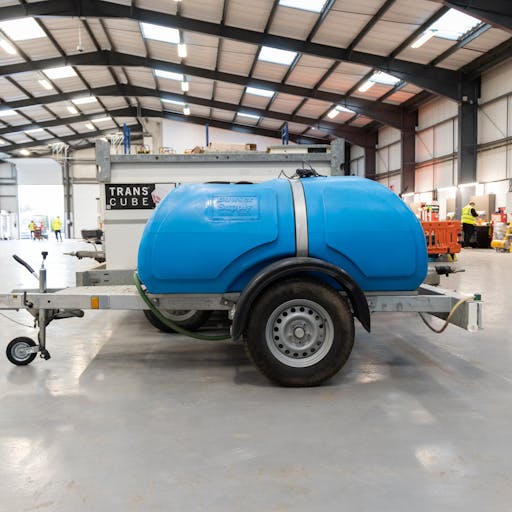15.04.24
A complete guide to choosing the right type of water bowser
Water bowsers play a vital role in construction sites, providing a convenient and reliable source of water for various tasks. Whether it's for dust suppression, concrete mixing, or general site cleaning, having the right water bowser can significantly enhance efficiency and productivity. In this comprehensive guide, we'll walk you through everything you need to know to select the perfect water bowser for your construction requirements.
Understanding Water Bowsers
Water bowsers, also known as water trailers or water tanks, are portable containers designed to transport and dispense water efficiently. They come in various sizes and configurations to suit different applications and job site requirements. Typically, a water bowser consists of a tank mounted on a trailer chassis, equipped with a pump and delivery system for easy distribution of water.
Applications of Water Bowsers
- Dust Suppression: One of the primary uses of water bowsers on construction sites is to suppress dust, which is a common problem during excavation, demolition, and earthmoving activities. By spraying water onto the ground or dusty surfaces, water bowsers help to weigh down dust particles, reducing airborne pollution and improving air quality.
- Concrete Mixing: Water bowsers are essential for concrete mixing operations, providing a steady supply of water to achieve the desired consistency and workability of the concrete mix. Proper hydration of concrete is crucial for its strength and durability, making water bowsers indispensable in construction projects involving concrete structures.
- Site Cleaning: Construction sites often require regular cleaning to maintain safety and hygiene standards. Water bowsers facilitate site cleaning by providing a convenient source of water for washing equipment, vehicles, and work areas, helping to keep the site organized and free from debris.
- Landscaping and Irrigation: In addition to construction applications, water bowsers are used in landscaping and irrigation projects to water plants, trees, and green areas. Their mobility and versatility make them ideal for watering remote or hard-to-reach locations without access to a fixed water supply.
 Road tow water bowser for hire
Road tow water bowser for hire
Choosing the Right Size and Type
Selecting the appropriate size and type of water bowser depends on several factors, including the specific tasks you need it for, the size of your construction site, and the frequency of use. Here are some key considerations to help you make an informed decision:
- Capacity: Water bowsers come in a range of tank capacities, typically measured in gallons or litres. Consider the volume of water you'll need for your intended applications and choose a bowser with sufficient capacity to meet your requirements without the need for frequent refills.
- Trailer Size: The size of the trailer chassis can affect the manoeuvrability and transportability of the water bowser. Ensure that the trailer size is compatible with your construction site layout and access points, especially if space is limited or if you need to move the bowser between multiple locations.
- Pump and Delivery System: Pay attention to the pump capacity and delivery system of the water bowser, as these components determine the rate at which water can be dispensed. A powerful pump and efficient delivery system are essential for achieving uniform coverage and maximizing productivity.
- Portability: If your construction project involves frequent relocation or off-road terrain, opt for a water bowser with rugged construction and robust tires for enhanced portability and durability in challenging conditions.
- Additional Features: Some water bowsers come with optional features such as hose reels, spray bars, and pressure washers, which can enhance versatility and functionality. Consider whether these additional features would be beneficial for your specific applications and workflow.
 Mounted pressure washer bowser for hire
Mounted pressure washer bowser for hire
Maintenance and Safety Considerations
Proper maintenance and safety practices are essential for ensuring the longevity and safe operation of your water bowser. Here are some tips to keep in mind:
- Regular Inspections: Schedule routine inspections of the water bowser to check for any signs of wear, damage, or leaks. Replace worn-out parts and components as needed to prevent malfunctions and ensure optimal performance.
- Cleaning and Sterilization: Clean the water bowser regularly to prevent bacterial growth and contamination. Use disinfectants or sterilizing agents to sanitize the tank and delivery system, especially if the water will be used for drinking or irrigation purposes.
- Safe Handling and Operation: Train operators on proper handling and operation procedures to prevent accidents and injuries. Ensure that all safety features, such as pressure relief valves and emergency shutoff switches, are functional and accessible at all times.
- Storage and Transportation: Store the water bowser in a secure location away from potential hazards such as fire, chemicals, or extreme temperatures. Secure the bowser properly during transportation to prevent tipping or shifting of the load.
Conclusion
Water bowsers are indispensable tools for construction projects, offering a versatile and convenient solution for water supply and distribution. By understanding your specific requirements and considering factors such as capacity, trailer size, and additional features, you can choose the right water bowser to enhance productivity and efficiency on your construction site. Remember to prioritize maintenance and safety to ensure the reliable performance and longevity of your water bowser investment.





